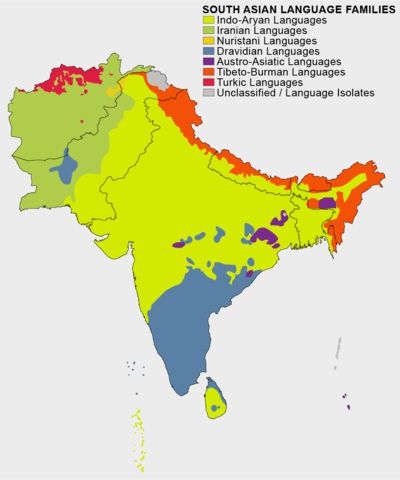Languages of South Asia


South Asia is home to several hundred languages, spanning the countries of Afghanistan, Bangladesh, Bhutan, India, Nepal, Pakistan and Sri Lanka. It is home to the third most spoken language in the world, Hindi-Urdu and the sixth most spoken language, Bengali. The Indo sub-continent majorly comprises of Aryan and Dravidian languages, and other minor families like Austroasiatic and Tibeto-Burman languages.
India[]
Most languages spoken in India belong either to the Indo-Aryan (c. 74%), the Dravidian (c. 24%), the Austroasiatic (Munda) (c. 1.2%), or the Tibeto-Burman (c. 0.6%) families, with some languages of the Himalayas still unclassified. The SIL Ethnologue lists 461 living languages for India.
Hindustani is the most widespread language of India. The Indian census takes the widest possible definition of "Hindi" as the broad variety of the Hindi languages. The native speakers of Hindi so defined account for 39% of Indians. Bengali is the second most spoken language of South Asia, found in both Bangladesh and Indian states of West Bengal and Tripura. The International Mother Language Day was created by UNESCO to commemorate the Bengali language.[1] Other notable languages include Odia, Telugu, Punjabi, Marathi, Tamil, Urdu, Gujarati, Kannada, Pashto, Malayalam and Konkani.
Indian English is recorded as the native language of 226,449 Indians in the 2001 census. English is the second "language of the Union" besides Hindi.
Thirteen languages account for more than 1% of Indian population each, and between themselves for over 95%; all of them are "scheduled languages of the constitution."
Scheduled languages spoken by less than 1% of Indians are Santali (0.64%), Manipuri (0.14%), Bodo (0.13%), Dogri (0.01%, spoken in Jammu and Kashmir). The largest language that is not "scheduled" is Bhili (0.95%), followed by Gondi (0.27%), Tulu (0.17%) and Kurukh (0.099%)
Nepal[]
Most of the languages of Nepal either fall under Indo-Aryan languages or Sino-Tibetan languages. The official language of the country is Nepali, earlier known as Gorkhali.
Pakistan[]
The major languages of Pakistan broadly fall under the category Indo-Iranian languages, with Western regions of Pakistan (close to Iran) speaking Iranian languages and Eastern regions (close to India) speaking Indo-Aryan languages (with the Indus River approximately dividing the families). The national uniting medium of Pakistan is Urdu, a standardized register of Hindustani language. The major native languages of Pakistan are Baluchi, Punjabi, Sindhi and Pashto, while other languages like Saraiki, Balti, etc. are also widely spoken.
See also[]
- Languages of Afghanistan
- Languages of Bangladesh
- Languages of Bhutan
- Languages of India
- Official languages of India
- List of languages by number of native speakers in India
- Languages of Maldives
- Languages of Sri Lanka
References[]
- ^ "The General Conference proclaim"International Mother Language Day" to be observed on 21 February". unesdoc.unesco.org. 1999-11-16. Retrieved 2019-04-21.
- Data table of Census of India, 2001
- "Indian Language Family". Central Institute of Indian Languages. Archived from the original on 15 June 2002.
- SCHEDULED LANGUAGES IN DESCENDING ORDER OF SPEAKERS' STRENGTH – 2001
- COMPARATIVE RANKING OF SCHEDULED LANGUAGES IN DESCENDING ORDER OF SPEAKERS' STRENGTH-1971, 1981, 1991 AND 2001
- Census data on Languages
External links[]
- Languages of South Asia
